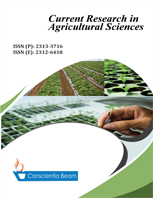Adaptation Study of Mung Bean (Vigna Radiate) Varieties in Raya Valley, Northern Ethiopia
DOI:
https://doi.org/10.18488/journal.68.2017.44.91.95Abstract
In order to investigate the adaptability of mung bean varities; a study was carried out at the research field of Mehoni Agricultural Research Center in 2014/15 cropping season. Nine varities were arranged in 3*3 lattice design with three replications in six rows per plot with 2.4 m wide and 4 m long, and with spacing of 40 cm between rows and 10 cm between plants. Days to flowering, Days to maturity, Plant height, number of pods per plant, number of seeds per pod, hundred seed weight and grain yield per hectare was significantly influenced by variety. The highest grain yield (1362.50 kg ha-1) was obtained from Black bean variety; followed by Shewa robit (1225.00 kg ha-1). On the contrary, the lowest grain yield value (242.60 kg ha-1) was obtained at MH BR-1 variety. Thus, both black bean and Shewa robit varities were best adapted in Raya valley.

